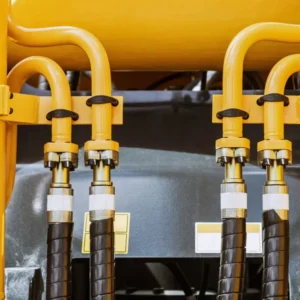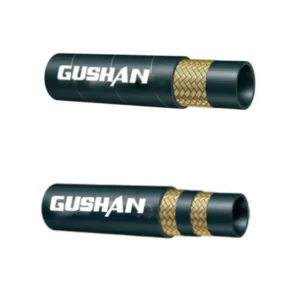The efficiency of any hydraulic or fluid transfer system is determined by a single, often-overlooked factor: friction loss. This phenomenon, where the flow of liquid is resisted by the inner wall of the hose, leads directly to a significant drop in pressure and wasted energy. Understanding the Rubber Hose Friction Factor is the first step in maximizing your system’s performance.
This comprehensive guide will demystify the science behind hose friction, including the roles of fluid velocity, hose diameter, and internal roughness. We’ll provide the practical knowledge and calculations you need to identify and solve pressure drop issues, ensuring your equipment runs at peak efficiency.
What is Rubber Hose Friction?
Rubber hose friction, often referred to as friction loss or head loss, is the resistance that a flowing fluid (liquid or gas) encounters from the inner surface of the hose, resulting in a drop in fluid pressure over the length of the hose.
This resistance is primarily caused by two factors: the viscosity of the fluid (internal friction between fluid layers) and the roughness of the hose’s internal wall, which creates turbulence and drag. The amount of friction is significantly affected by the fluid’s velocity and the hose’s diameter and length, and it must be accounted for in system design to ensure adequate pressure and flow at the point of use, typically by using equations like the Darcy-Weisbach or Hazen-Williams formulas.
Rubber Hose Friction Factor
The Rubber Hose Friction Factor (f) is a dimensionless number used in fluid dynamics to quantify the resistance to fluid flow inside a hose. It forms the central component of the Darcy-Weisbach equation, linking the internal surface conditions of the rubber to the resultant pressure loss, or head loss, across the hose’s length.
It acts as a critical measure of flow efficiency. A higher friction factor indicates a rougher interior surface or increased turbulence, meaning the pump must expend more energy to push the fluid through. For rubber hoses, this factor is essential for calculating the true power output of a system.
Fluid Flow Regimes
The value of the friction factor depends fundamentally on the fluid’s behavior, which is classified by the Reynolds number (Re). At low Reynolds numbers, the flow is laminar (smooth and orderly), and the friction factor is a simple function of Re.
Conversely, at high Reynolds numbers, the flow becomes turbulent (chaotic and mixing). In this turbulent regime, the friction factor is heavily influenced by the internal relative roughness of the rubber hose—the ratio of the hose wall’s surface texture to its diameter.
The Role of Internal Roughness
While rubber is generally considered a “smooth” material compared to steel or concrete pipes, its absolute roughness still dictates the friction factor in turbulent flow. Manufacturing imperfections, internal wire reinforcement patterns, or material degradation can increase this roughness.
Even microscopic irregularities on the inner lining create tiny eddies and turbulence, which dissipate energy and increase the friction factor. Engineers aim to select high-quality hoses with a minimal and consistent inner surface roughness to maintain a low and predictable friction factor.
Determining the Friction Factor
For turbulent flow, the friction factor is typically determined using the Moody Chart or a numerical solution of the Colebrook equation. This requires inputting the hose’s relative roughness and the calculated Reynolds number for the flow conditions.
In practical engineering, simplified empirical formulas or established tables for specific hose types are often used as an initial estimation. However, for high-accuracy systems, a precise calculation using the appropriate fluid dynamics model is necessary to minimize errors in pressure drop prediction.
Minimizing Pressure Loss
The primary goal of understanding the friction factor is to minimize the inevitable pressure loss. Since the head loss is directly proportional to the friction factor and the square of the flow velocity, strategic adjustments are vital.
To reduce the friction factor’s impact, engineers can select a hose with a larger internal diameter (to reduce velocity) or specify a hose made with a smoother compound. These measures directly reduce both the turbulence and the shear stress at the hose wall, leading to maximum flow efficiency.
What Determines Rubber Hose Friction
What determines rubber hose friction are the physical properties of the fluid, the flow characteristics, and the geometry and material of the hose itself. These factors combine to create the total resistance a fluid encounters, resulting in pressure loss across the hose’s length.
Understanding these determinants is crucial for engineers designing fluid transfer systems. They allow for accurate prediction of system head loss and ensure the chosen hose size and pump power will deliver the required flow rate and pressure at the point of application.
Key Determinants of Rubber Hose Friction
- Fluid Properties: The viscosity and density of the fluid are primary determinants. A more viscous (“thicker”) fluid, like heavy oil, exhibits greater internal friction between its own layers, generating more shear stress at the hose wall compared to a less viscous fluid, like water, thus increasing the friction loss.
- Flow Rate and Velocity: Friction loss is highly sensitive to the flow rate and the resulting velocity of the fluid. An increase in flow velocity causes the flow regime to transition from smooth laminar to turbulent, where resistance grows proportionally to the square of the velocity, significantly increasing friction and pressure drop.
- Hose Internal Diameter (ID): The internal diameter has an inverse and powerful effect on friction. For a constant flow rate, a smaller ID forces the fluid to move faster, sharply increasing its velocity and generating high friction. Conversely, using a larger ID significantly reduces velocity and the resulting pressure loss.
- Hose Length and Roughness: The total length of the hose directly dictates the surface area over which friction can occur, leading to a linear increase in loss. The microscopic internal roughness of the rubber lining contributes to turbulence and is quantified by the friction factor, which must be low for efficient transfer.
Conclusion
Understanding and mastering the Rubber Hose Friction Factor is essential for optimizing any fluid delivery system, translating directly into saved energy and reduced wear on your pumps. By applying the principles of the Darcy-Weisbach equation, carefully selecting the right diameter, and ensuring smooth flow (low Reynolds number), you can effectively control pressure loss. This vigilance guarantees your system achieves its rated performance consistently.
The core solution for minimizing friction loss starts with choosing a high-quality hose built for optimal flow and durability. Hoses with smoother inner linings and precise internal diameters inherently reduce turbulence and resistance, maximizing the pressure delivered to the working component. Never compromise on hose quality—it is the direct artery of your hydraulic or pneumatic system’s power.
For the most reliable and efficient solutions for your fluid transfer needs, source your wholesale rubber hoses from our Gushan Rubber catalog. Our products are engineered with superior internal finishes and pressure tolerances to ensure minimal friction loss, providing the quality and performance you need for any demanding industrial or construction application.



